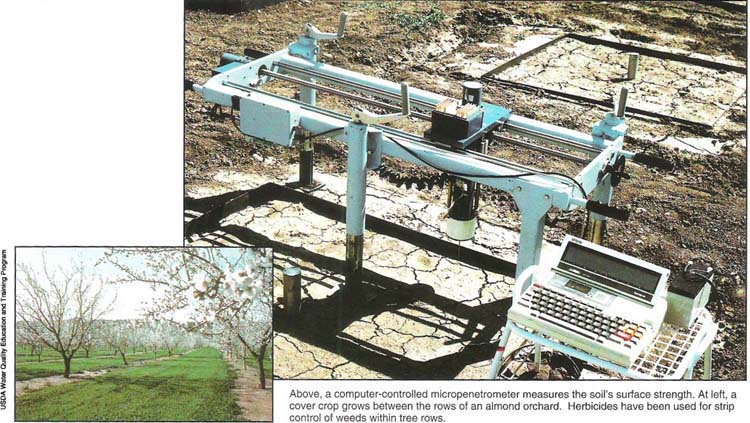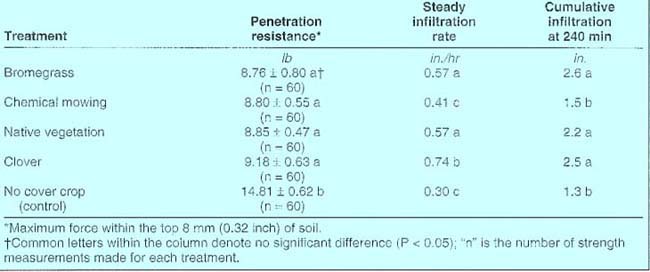All Issues
Cover crops lower soil surface strength, may improve soil permeability
Publication Information
California Agriculture 46(6):26-27.
Published November 01, 1992
PDF | Citation | Permissions
Abstract
Poor water penetration constitutes a major production constraint for more than 400, 000 acres of agricultural land in California. The associated economic losses are particularly appreciable in the production of fruit and nut crops. In response to a hypothesis that cover crops may improve water infiltration in orchards, studies were conducted at Davis and Ceres. After 3 years' study, results indicate major benefits are possible with the planting of cover crops.
Full text
Above, a computer-controlled micropenetrometer measures the soil's surface strength. At left, a cover crop grows between the rows of an almond orchard. Herbicides have been used for strip control of weeds within tree rows.
Slow water penetration constrains crop production on more than 400,000 acres (1 million hectares) of agricultural land in California. Economic losses associated with poor water penetration have been estimated as high as $486 per acre ($1,200 per hectare) for orchards. Among the causes of poor water penetration identified in California's Central Valley are naturally occurring dense layers within the soil profile, compaction created by vehicular traffic and soil tillage implements, and surface crusting and sealing resulting from disruption of soil aggregates by rain or irrigation water. Surface crusting and sealing cause soil density and surface strength to increase. Because surface crusts are known to resist infiltration, and crust strength is a measure of density and other properties of crusts, measuring the surface strength of a soil may help predict potential infiltration problems.
Some Central Valley growers have reported success in using cover crops to improve soil permeability; others report more disappointing results. This apparent inconsistency may indicate that the permeability problems have different causes. If poor surface soil perrneability were the factor limiting water intake, one would expect the use of cover crops to improve the intake rate. On the other hand, if subsoil permeability were the limiting factor, several years of cover crops might improve the properties of the surface soil but would not necessarily improve the water intake rate. The cover crop would, however, be expected to reduce the soil's surface strength.
Field studies
Studies were conducted at Davis and Ceres after several grower-controlled irrigations. Soil surface strength was measured as penetration resistance, using a computer-controlled micropenetrometer. All measurements of penetration resistance were made to a depth of 5 mm (0.2 inch) in Davis and to 8 mm (0.32 inch) in Ceres under air-dry soil surface conditions. Maximum force over the depth measured was taken as an index of the soil surface strength. The infiltration rate was measured by a portable, computer-controlled, rainfall infiltrometer. Soil water contents when penetration resistance and infiltration rate were measured at the Davis and Ceres sites were 0.053 and 0.03 grams of water per gram of soil, respectively.
Davis. This Davis site was chosen to investigate the effect of different cover crops on soil surface strength and infiltration rate. The soil is a Yolo loam (fine-silty, mixed, nonacid, thermic Typic Xerorthent). The three cover crop treatments, in four replications, were oat-vetch mixture, vetch, and no cover crop (control). The cover crops were planted in winter, and followed by tomato in spring. All infiltration and penetration resistance measurements were made in spring when the plots were under the tomato crop. Measurements were made after about 3 years of cover cropping.
Ceres. The Ceres site's soil is a Hanford sandy loam (coarse-loamy, mixed, nonacid, thermic Typic Xerorthent). Hanford sandy loams, generally known to have poor water intake characteristics, are represented extensively on the San Joaquin Valley's east side. The Ceres site, an almond orchard, was chosen to investigate the effect of different cover crops on soil surface strength and infiltration rate. Penetration resistance and infiltration rate were measured at locations within the orchard that were least disturbed and were free of vehicular traffic and plant residues.
Measurements were made in the orchard about 5 years after several cover crops were established. Tested in four replications, were Blando bromegrass, chemical mowing, native vegetation, strawberry clover, and bare soil (control). In the chemical mowing treatment, a low dose of herbicide was used to retard growth of the native vegetation but not eliminate it. Soil surface strength and infiltration rate were measured under various cover crop treatments.
Crust strength, soil permeability
Davis. At the Davis site, cover crops significantly lowered soil surface strength (table 1). The oat-vetch mixture appeared to have a greater moderating effect on surface crust strength than did vetch alone. Mean surface strengths of the oat-vetch and vetch treatments were about 41 and 24% lower, respectively, than that of the control. The lower surface strength under the winter cover crops probably resulted from the cover crops' protecting the surface aggregates against the disruptive impact of raindrops and from better aggregation of the soil surface, which in turn resulted from incorporating more organic materials into the soil. Improved aggregation would be expected to increase the aggregate's resistance to breakdown and dispersion, thereby reducing the soil's vulnerability to surface sealing.
Although the initial and steady infiltration rates were not significantly increased by cover crops (table 1), cumulative water intake over 4 hours was significantly greater than for the control. The highest cumulative intake was recorded under vetch. These results indicate the potential for winter cover crops to improve root zone water recharge through increased infiltration and reduced runoff. A decrease in ponding time may also help soil aeration. Lower soil surface strength resulting from winter cover crops can also be expected to reduce surface mechanical impedance to seedling emergence, particularly in soils susceptible to surface crusting.
Ceres. At Ceres, the soils' surface resistance to penetration under the four cover crop treatments, although not significantly different from one another, were about 38 to 41% lower than the surface resistance readings of the control (table 2). Unlike the Davis cover crop treatments, the lower surface resistance observed under the Ceres cover crops was reflected in higher steady infiltration rates in addition to higher cumulative water intake during a 4-hour period. Steady infiltration rate and cumulative water intake under the cover crops were 37 to 147% and 20 to 101% higher, respectively, than those of the control. Thus it appears that surface permeability at Ceres limited the steady-state infiltration rate, whereas at Davis the infiltration rate was limited by subsoil permeability problems. Infiltration rates in the control plots were much lower at Ceres than at Davis. Mean surface strength at Ceres was 10 times larger than at Davis, indicating a possible relationship between crust strength and infiltration.
Conclusion
Although results at both Ceres and Davis showed winter cover crops to reduce soil surface strength and increase cumulative water intake, the effect of cover crops on the steady infiltration rate differed at the two sites. These results indicate that cover crops have the potential both to reduce soil surface strength and to increase soil permeability.







